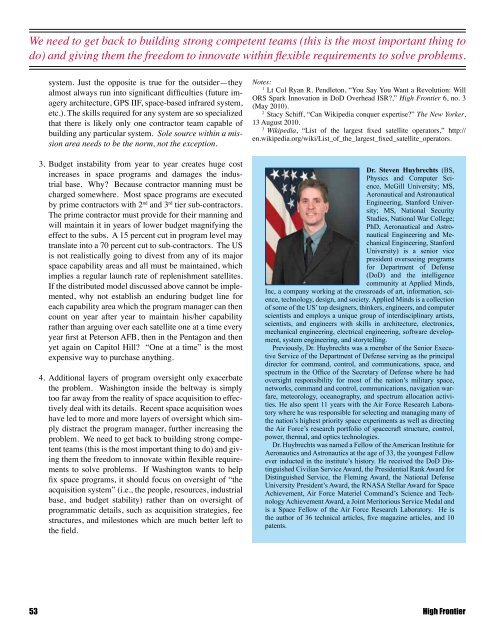Schriever Wargame 2010 - Air Force Space Command
Schriever Wargame 2010 - Air Force Space Command
Schriever Wargame 2010 - Air Force Space Command
You also want an ePaper? Increase the reach of your titles
YUMPU automatically turns print PDFs into web optimized ePapers that Google loves.
We need to get back to building strong competent teams (this is the most important thing to<br />
do) and giving them the freedom to innovate within flexible requirements to solve problems.<br />
system. Just the opposite is true for the outsider—they<br />
almost always run into significant difficulties (future imagery<br />
architecture, GPS IIF, space-based infrared system,<br />
etc.). The skills required for any system are so specialized<br />
that there is likely only one contractor team capable of<br />
building any particular system. Sole source within a mission<br />
area needs to be the norm, not the exception.<br />
3. Budget instability from year to year creates huge cost<br />
increases in space programs and damages the industrial<br />
base. Why? Because contractor manning must be<br />
charged somewhere. Most space programs are executed<br />
by prime contractors with 2 nd and 3 rd tier sub-contractors.<br />
The prime contractor must provide for their manning and<br />
will maintain it in years of lower budget magnifying the<br />
effect to the subs. A 15 percent cut in program level may<br />
translate into a 70 percent cut to sub-contractors. The US<br />
is not realistically going to divest from any of its major<br />
space capability areas and all must be maintained, which<br />
implies a regular launch rate of replenishment satellites.<br />
If the distributed model discussed above cannot be implemented,<br />
why not establish an enduring budget line for<br />
each capability area which the program manager can then<br />
count on year after year to maintain his/her capability<br />
rather than arguing over each satellite one at a time every<br />
year first at Peterson AFB, then in the Pentagon and then<br />
yet again on Capitol Hill? “One at a time” is the most<br />
expensive way to purchase anything.<br />
4. Additional layers of program oversight only exacerbate<br />
the problem. Washington inside the beltway is simply<br />
too far away from the reality of space acquisition to effectively<br />
deal with its details. Recent space acquisition woes<br />
have led to more and more layers of oversight which simply<br />
distract the program manager, further increasing the<br />
problem. We need to get back to building strong competent<br />
teams (this is the most important thing to do) and giving<br />
them the freedom to innovate within flexible requirements<br />
to solve problems. If Washington wants to help<br />
fix space programs, it should focus on oversight of “the<br />
acquisition system” (i.e., the people, resources, industrial<br />
base, and budget stability) rather than on oversight of<br />
programmatic details, such as acquisition strategies, fee<br />
structures, and milestones which are much better left to<br />
the field.<br />
Notes:<br />
1<br />
Lt Col Ryan R. Pendleton, “You Say You Want a Revolution: Will<br />
ORS Spark Innovation in DoD Overhead ISR?,” High Frontier 6, no. 3<br />
(May <strong>2010</strong>).<br />
2<br />
Stacy Schiff, “Can Wikipedia conquer expertise?” The New Yorker,<br />
13 August <strong>2010</strong>.<br />
3<br />
Wikipedia, “List of the largest fixed satellite operators,” http://<br />
en.wikipedia.org/wiki/List_of_the_largest_fixed_satellite_operators.<br />
Dr. Steven Huybrechts (BS,<br />
Physics and Computer Science,<br />
McGill University; MS,<br />
Aeronautical and Astronautical<br />
Engineering, Stanford University;<br />
MS, National Security<br />
Studies, National War College;<br />
PhD, Aeronautical and Astronautical<br />
Engineering and Mechanical<br />
Engineering, Stanford<br />
University) is a senior vice<br />
president overseeing programs<br />
for Department of Defense<br />
(DoD) and the intelligence<br />
community at Applied Minds,<br />
Inc, a company working at the crossroads of art, information, science,<br />
technology, design, and society. Applied Minds is a collection<br />
of some of the US’ top designers, thinkers, engineers, and computer<br />
scientists and employs a unique group of interdisciplinary artists,<br />
scientists, and engineers with skills in architecture, electronics,<br />
mechanical engineering, electrical engineering, software development,<br />
system engineering, and storytelling.<br />
Previously, Dr. Huybrechts was a member of the Senior Executive<br />
Service of the Department of Defense serving as the principal<br />
director for command, control, and communications, space, and<br />
spectrum in the Office of the Secretary of Defense where he had<br />
oversight responsibility for most of the nation’s military space,<br />
networks, command and control, communications, navigation warfare,<br />
meteorology, oceanography, and spectrum allocation activities.<br />
He also spent 11 years with the <strong>Air</strong> <strong>Force</strong> Research Laboratory<br />
where he was responsible for selecting and managing many of<br />
the nation’s highest priority space experiments as well as directing<br />
the <strong>Air</strong> <strong>Force</strong>’s research portfolio of spacecraft structure, control,<br />
power, thermal, and optics technologies.<br />
Dr. Huybrechts was named a Fellow of the American Institute for<br />
Aeronautics and Astronautics at the age of 33, the youngest Fellow<br />
ever inducted in the institute’s history. He received the DoD Distinguished<br />
Civilian Service Award, the Presidential Rank Award for<br />
Distinguished Service, the Fleming Award, the National Defense<br />
University President’s Award, the RNASA Stellar Award for <strong>Space</strong><br />
Achievement, <strong>Air</strong> <strong>Force</strong> Materiel <strong>Command</strong>’s Science and Technology<br />
Achievement Award, a Joint Meritorious Service Medal and<br />
is a <strong>Space</strong> Fellow of the <strong>Air</strong> <strong>Force</strong> Research Laboratory. He is<br />
the author of 36 technical articles, five magazine articles, and 10<br />
patents.<br />
53 High Frontier

















